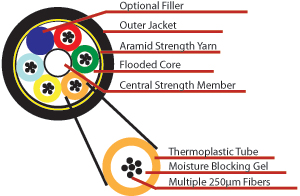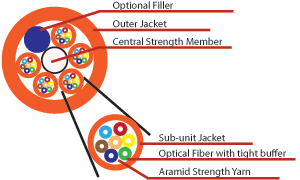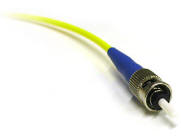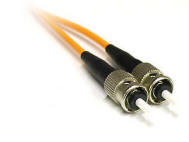Fiber optics use light pulses rather than electrical signals to transport information.
Get more information from our Fiber Optic Glossary.
How Does it Work
Digitized information is “coded,” or placed on light pulses for transmission. That information travels along the glass fiber at the speed of light (186,000 miles/second). When it reaches its destination, a decoder converts the light information into a picture, audio or written form that we can understand.
Fiber Optic Cable
Fiber optic cables consist of the following components:
Core – Transparent plastic or glass through which light travels
Cladding – Glass covering surrounding the core that acts as a mirror to reflect light back into the core. This is called total internal reflection
Buffer coating – Coats and protects the fiber
Aramid yarn strength member – Reinforces the integrity of data transmission through the optical fibers in the cable
Protective outer jacket – Extruded PVC is typical
Fiber Cable Designs
There are two basic types of cable design. They are: Loose Tube (typically used for “OSP” outside plant installations) and Tight Buffered (typically used for inside installations).
 Loose Tube fiber cable consists of:
Loose Tube fiber cable consists of:
- Multiple 250µm coated fibers
- One or more loose tubes holding those fibers
- Gel-fill to block moisture and protect movement of the fibers
- Central strength member
- Aramid yarn strength member
- Outer jacket
 Tight Buffered fiber cable consists of:
Tight Buffered fiber cable consists of:
- 900µm tight buffer around a 250µm fiber
- Central Strength member
- Aramid yarn strength member
- Outer jacket
Fiber Cable Types
There are two basic types of cable. Simplex and Duplex. Both types of cable come in: Singlemode and Multimode. Singlemode is for long distance cable runs and Multimode is for shorter cable runs.
Simplex Cable

Simplex fiber optic cable consists of a single fiber and is typically used in applications that only require one-way data transfer.
Example: An interstate trucking scale that sends the weight of the truck to a monitoring station, an oil line monitor that sends data about oil flow to a central location, or a radio station that broadcasts out to its listeners.
Duplex Cable

Duplex fiber optic cable consists of two fibers and is typically used for applications that require simultaneous, bi-directional data transfer.
Example: Workstations, fiber switches and servers, fiber modems, and similar hardware require duplex cable.
Fiber Optic Tools and Test Equipment
With every fiber install, special tools and equipment are required to complete the job.
Fiber Optic Splitters
A fiber optic splitter combines light signals and splits them out over single or multiple outputs. Multicom splitters are immune to electro-magnetic interference (EMI), consume no electrical power, and do not add noise to system design.
Multicom splitters can be fabricated in custom fiber lengths and with any type of connector.

